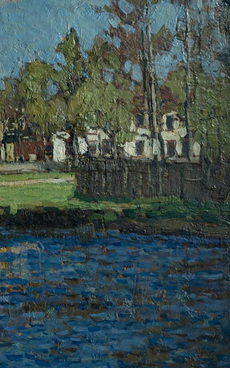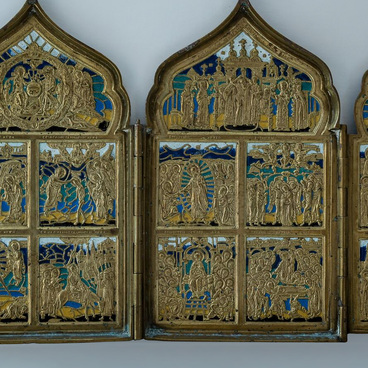The displayed large cast icon presents the extended version of the traditional iconographic depiction of the “Dormition of the Virgin with the Miraculous Cloud”. The upper part is occupied by the image of the twelve apostles on teardrop-shaped clouds, miraculously transported by angels to the place of the Dormition — to Jerusalem, to the house of John the Apostle.
This version of the “Dormition” has been known since the 16th century. In the upper part, between the apostles, is the scene “The Assumption of the Virgin”: the Mother of God sits on an ascending throne (against the background of a blue-green disk) with angels on the sides. Jerusalem is indicated by a traditional architectural element: a fortress wall with towers dividing the composition into two halves.
In the lower part is the actual plot of the Dormition: the bier with the Theotokos falling asleep is surrounded by the apostles; above the bier is Christ with the soul of the Mother in His left hand. Her soul is symbolically depicted as an infant figure.
In the foreground in front of the bier is a scene with Athonios, a man who tried to push over the bier with the body of the Blessed Virgin. An angel cuts off his hands with a sword, which regrew after he repented. These successive events are shown in a traditional iconographic technique using the appropriate iconographic signs: the angel raises a sword over the hands of the sacrilegious man, whose severed hands already hang in the air.
The fields feature a decorative motif based on a combination of lilies enclosed in teardrop-shaped backgrounds and rosettes elongated in the shape of a diamond. The icon is dominated by blue and its various shades, characteristic of the feast of the Assumption of the Virgin. There are also spots of yellow, white, black, and green enamel. This image is densely saturated with relief details, creating a dense vivid “carpet”.
The creation of enameled works is a complex craft
that requires a variety of skills. It is necessary to make a cast metal base so
that there are recesses for the background between the protruding reliefs — the
base for applying enamel. Certain areas of the base are filled with multicolored
glass powders, and the item is sent to be fired. The powders are sintered, and a
vitreous film forms. The powders then acquire the final color due to high
temperature and turn into enamel.


